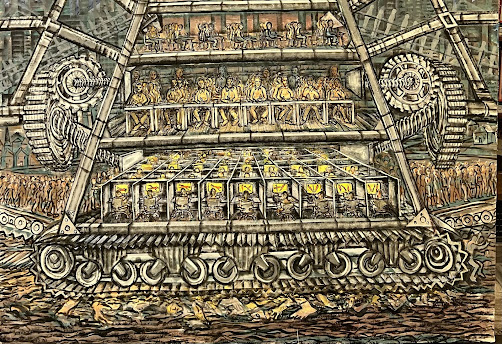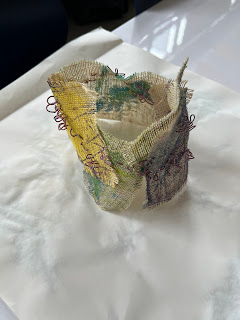Transition To Choice Based Art Education
Saturday, June 14, 2025
School Alienation
Monday, June 02, 2025
My Retirement From K12 Art Education
 |
| Alex and I work on a huge cardboard T-Rex sculpture that was exhibited at Greenfield Central HS in 2024. |
It's true. I'm officially retired from K12 art education. That does not mean I'm finished with art and art education. This article by Kristi Deer of the Greenfield Reporter is a beautiful send-off and encapsulates my work at New Palestine Schools and Teaching for Artistic Behavior.
 |
| 2005 NAEA photo: George Szekely, Katherine Douglas, Pauline Joseph, Clyde Gaw, John Crowe, Diane Jaquith and Clark Fralick. |
I am most indebted to Clark Fralick who in 2004, introduced me to Katherine Douglas, Diane Jaquith, John Crowe and Pauline Joseph. My work with Clark, the Teaching for Artistic Behavior (TAB) Founders, my FB and TABSTOCK colleagues Candi Poll-Price, Lisa Van Plew, Julie Toole, Jeff Pride and the rest of my TAB colleague practitioners has been incredibly benevolent to me professionally and personally and I will be indebted to the TAB art education movement forever.
I say art education movement because TAB is not only a philosophy and approach to curriculum but an educational movement that for the past 20 years, has reverberated in primary and secondary schools throughout the World.
What is the essence of TAB that has led this educational approach to become such a force in contemporary art education? My take? TAB curriculum experiences inside K12 institutional settings offer students the opportunity to encounter art education activity at the most personal and profound level of experience.
This answer is multifaceted because when learning is personal and profound, benevolence is a byproduct of the experience.
 |
| Isobel prepares to add to her mixed media sculpture inside our New Palestine High School TAB art studio in 2023. |
Benevolence inside a TAB studio setting simply put, means that children are receiving interpersonal support in their intellectual development and as a result their perception of self and their learning is positively affirmed. A reason children don’t want to leave TAB art class when the bell rings is benevolent experience. School becomes a place of joyful and impactful learning wherever TAB studio settings exist.
 |
| The TAB Institute faculty returns to MassArt from July 13th-18th. |
My time at MassArt and the TAB Institute has been filled with incredible memories. I hope to continue my activities for as long as I can at MassArt. You can register for the TAB Institute here:
 |
| With Clark Fralick and our cardboard marble-run tornado sculpture. |
Sunday, April 20, 2025
EARCOS Conference: Art Education Takes Flight!
The educators of the East Asia Regional Conference of Schools (EARCOS) recognize the power of experiential education and are serious about providing children opportunities for intellectual and creative development through the visual arts.
EARCOS is a large network of independent K12 international schools who strive to provide best practices through progressive, child-centered curricula.
I was thrilled to have the opportunity to offer a TAB studio workshop and present several times at the International School of Kuala Lumpur where the 2025 Spring EARCOS conference was held. I have nothing but the highest praise for the conference organizers including Dr. Ed Greene, Maica Cruz, Dr. Catriona Moran, Nick Stonehouse, and the rest of the EARCOS Board of Trustees who organized this incredible professional development event!
What I was so impressed with was the enthusiasm and interest the 120 or so EARCOS art teachers I came into contact with had for Teaching for Artistic Behavior (TAB) and choice-based art education. To say they were interested in these topics is an understatement.
One of the highlights of my time at the conference, were the studio workshops that we held. On the first day, the pre-conference, 35 educators showed up for seven hours of TAB studio time! What a fantastic experience we had! The art work produced by the participants was amazing! The learning intense! More on the EARCOS Conference experience soon!
Thursday, May 23, 2024
Tyrannosaurus Rex Sculpture: Project-Based Studio Centers
Whole families wanted to take a photograph with our special project!
The sculpture returned to the art room at New Palestine High School after the show was over.
Tuesday, March 26, 2024
School Arts: April 2024 Issue!
When Nancy Walkup asked me to help her with another issue of School Arts dedicated to TAB and Choice-Based Art Education, I was thrilled to assist! We put a call out for articles to our Family of Educators on the TAB Facebook Forum and Mighty Networks where lots of folks fearlessly stepped up! Nancy and I are indebted to all the wonderful authors who participated in this project. Here is the link to the April School Arts issue on Davis Publication's website, granddaughter Presley featured in the magazine and also pics from my classroom and Indiana Youth Art Month Celebration!
https://www.davisart.com/schoolarts/issues/2024/choice/















































